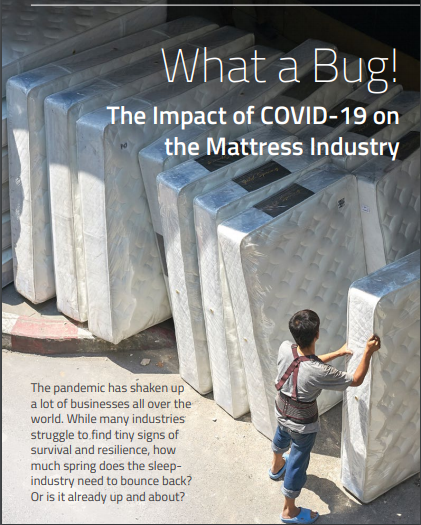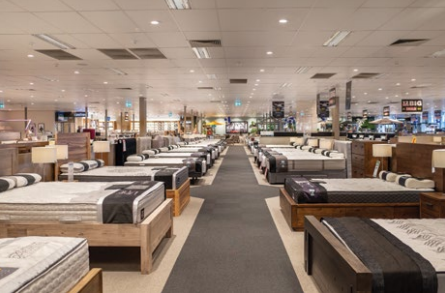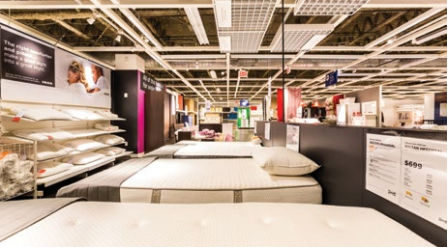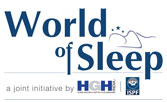
As the world waits with bated breath for a vaccine, some of us may have been tempted at some point to search about the evolution of the very idea of a vaccine. Interestingly, most vaccines are nothing but some doses of the bacteria or virus itself. When administered carefully, and with a proper plan, even a harmful element can change into a helpful antidote.
No one would understand that better than players in the mattress industry. For years and years, both top-tier and emerging businesses here have struggled with many deep-running issues – a dominant unorganised texture of the market, lack of standardisation, customisation challenges, distribution problems, lack of innovation and absence of customer awareness, to name a few. What was the most unwieldy one here, however, was the perception of ‘sleep’ per se. Neither the average customer bothered about the importance of a good mattress or a sleep accessory, nor the marketers talked about sleep health as part of their promotions.
So when everyone was forced to not just stay indoors but also work from there during the lockdown, a strange shift happened. People suddenly realized that the more time they spent at home, the more they paid attention to the comfort and quality of that thing called ‘mattress’. Among other home renovation efforts; spending on, and upgrading, products related to sleep also came on the top of the Indian customer’s radar. At the same time, the industry was grappling with general issues that were causing trouble in other business segments due to the pandemic – like a lukewarm economic outlook, a dip in overall spending, a long pause on retail activity, logistics and supply-chain bottlenecks. So has the crisis worked like a vaccine or as a virus? Did the pandemic emerge as good news or bad news for the industry?

Even the latest U.S. Census Bureau report is a big hint here. Turns out that home centres, hardware stores, garden centres and building materials suppliers realized a year-over-year sales spike of 22.6 percent. This dominated all retail categories except for online purchases. Retailers are now serving the home improvement market as homeowners are doing projects during the pandemic. Another research, from Consumer Specialists (a research and consulting firm specializing in home improvement-related industries) and the Home Projects Council, notes 57 percent of homeowners put an emphasis on home improvement during the first three months of COVID-19.
Looks like these homeowners spent $1,750 making home improvements. A lot of them (66.9 percent) explained time as the primary reason driving their efforts. As many as 50 percent of homeowners said – “time at home made me more aware of things that needed doing”. It was also observed here that home improvement project intent during the next year is actually up slightly despite the pandemic.
So the wave had already started. It will not subside after the pandemic and may find more force as people look at their homes differently and for longer hours now. It is not hard to imagine the depth and volume of spending that will come into home-improvement spill-over areas. Mattresses and home comfort products would ultimately gain from the positive ramifications of the surge that is being witnessed in the home improvement space. Customers have been woken up to the vast realm of possibilities and needs that they are now realizing due to the extended lockdown. The spending on mattresses as a category can be discretionary and replacement-oriented also but it would, nonetheless, be a segment where customers are paying attention. Unlike other businesses that have been deferred to a ‘post lockdown’ category in the customer’s mind, this space would find a new wave of demand that has to be met with the right offerings, experience, service and innovation by the players of the industry.
Supply Chains and Factories – Surviving the Blow
It is not hard to dismiss the dent in manufacturing and logistics that has been felt due to the pandemic. But the impact suffered by manufacturing is only serious on the supply-chain side while for other functions the impact is starker, deeper, multi-dimensional and less temporary – as shared by Mahesh Narayanan Gopalasamudram, COO, Sheela Foam, “In manufacturing, we are 70 percent of where we were. But sales and marketing are a tad stressed out. However, post-lockdown lot of things will change forever.”
Speaking on the lockdown effect on logistics and supply chain, he says that the lockdown has impacted logistics and supply-chain majorly. “We realized two points when the government imposed lockdown. First, it would be hard to get contractual employees and logistics would be difficult due to the non-availability of drivers and restrictions at the check post and vehicular movement etc. So, we decided to simplify most of our manufacturing and supply chain processes and increased automation. This helped us in maintaining the supply-demand equation. Even our supply chain partners could manage in sending required raw material with the existing and available stock”, he adds.

He explains that consumer-side-facing business areas have been severely affected while manufacturing areas are not laden with as many worries as those functions have. After all, a lockdown brings down customer mobility to a significant degree. Brijraj Chaitanya Desai, Business Manager, Industrial Adhesives, Pidilite Industries Limited surmises that the short-term outlook is bad but the mid-term and long-term view is good for the organised segment. “There is a direct impact on manufacturing and logistics because of frequent lockdowns. The supply chain has suffered from erratic production and scheduling issues due to a lack of clarity on interstate transport movement. Functions like marketing can still be remotely managed so they are still not affected badly. But at the end of the day, if demand does not pick up, it will affect everything.”
He is also noting a shift in the way product quality and component focus will be embraced now. “Our company, as an adhesive maker, has an opportunity to work with a cross-section of the industry – like dealers, unorganised players, organised players etc. We see that going forward, those companies that will become nimble with the cost structure and go-to-market strategies will fare better than traditional networks and approaches. We have already started witnessing a transformation from brick-and-mortar to omnichannel models, and this trend will only amplify ahead. A lot of e-commerce start-ups will proliferate ahead. Aspects like semiautomation and quality consumables will get stronger. So consider that adhesives may make five to seven percent of mattress manufacturing but in terms of risk of failure, the impact is very significant.
Another change will be that of industry consolidation in favour of organised players. This is because some unorganised players may not have deep pockets to survive the pandemic. Going ahead, the real craft for any company would be in its business model. The organised segment would be able to bounce sooner than others because of financial resilience and better brand equity.”

The Bitter-Sweet Reality
While people may have realized the importance of home comfort and products like mattresses during the lockdown, it would be imprudent to shrug away the hard changes that this period has inflicted on the industry.
It is evident in the Mckinsey survey as well that the speed of going online has accelerated for consumers – with 20 to 60 more consumers who are now digital. This indicates a metamorphosis of demand – and turns out that it is unlikely to reverse quickly. All that is manifesting into new behaviour patterns – like switching has accelerated.
Interestingly, as per Moengage, North America and India have seen a notable jump in active users respectively, on online shopping apps. Consumers in Southeast Asia have shown some hesitation to shop online because conversions have plummeted to their lowest.
What Next?
Let’s look at what ‘Innovation in a Crisis’, a report from McKinsey & Company told recently. This survey of more than 200 organizations across industries indicated that over 90 percent of executives expect the fallout from COVID-19 to fundamentally change the way they do business over the next five years. Most of them are asserting that the crisis will have a lasting impact on their customers’ needs.
Ironically, the most important need here – innovation – can easily be put on a back-burner as businesses focus on ‘survival’. The report notes that executives are busy weighing costs, driving productivity, and implementing safety measures against supporting innovation-led growth. Investments in innovation are suffering. Most executives feel that they will return to innovation-related initiatives once the world has stabilized. They want to secure the core first until the path forward is clearer. But maybe the smart thing to do is what merely a quarter of these executives are doing – capturing new growth as a top priority (first- or second-order). It is easy to belong to the 60 percent that did so before the crisis hit. But that’s not going to drive businesses into the post-survival set of challenges and opportunities. It is easy to lose sight of innovating when all hands are on deck. But this is exactly the time to look for the new swathe of customer needs and market gaps that will unfold once the storm is past and once the dust settles. The industry should make sure that it is riding the waves of ‘attention to home’ and ‘health’ in a strong way and with the right offerings. That is something that cannot be postponed until the lockdowns ease out.
Innovation is the best way to move forward. Many players are moving to significant value engineering and are trying to also bring hygienic products with anti-microbial qualities into their portfolio. Companies are also ensuring that when it comes to the store experience, the buying process is done in sanitised, spacious, well-aerated and low-risk environments.
The industry should be prepared to continue and build up on the momentum after the lockdowns ease out. Once the lockdowns lift properly, there would be two segments that will be strong and will grow from value-addition by mattress makers: hygiene and offerings like anti-bacterial or anti-mosquito products as Sanjeev Kapoor, CEO, of Indian Silks, tells.
K.Senthilprabhu, Vice President, Sales Mattress & Cover division, Global Textile Alliance India Pvt Ltd also feels that in the next few months when things normalise, we expect good momentum in the retail segment. “There is a lot of demand in the online segment.”
Consider how Vivek Iyer, Partner, Financial Services, PwC assesses the scenario here. “There is a lot of pent-up demand that will see some traction as people emerge out of the lockdown. While the lockdown has surely impacted the medium of delivery of the demand, the demand exists. I will try to explain this with an example. If there is a demand for a pair of t-shirts, the same would be ordered by a digital app ( Myntra for example) rather than buying it from a store. The demand for clothes is there, but the medium of delivery is digitally enabled. The Z-shaped recovery stems from many examples like this where pent-up demand would explode and then settle back to the long-term trend level.
Consumption is not affected in a hard-to-redeem way during the lockdown, the way he sees it. “Discretionary spending will be back to its original levels, as discretionary spending came from a certain demography that was unable to spend during the lockdown. As mentioned earlier, so far as the mode of delivering the demand is within the acceptable parameters of social distancing, the discretionary spending will be back.”
As to how India Inc. should respond to the new set of challenges and how industries like wellness, mattress, home improvement and lifestyle should re-orient themselves, Iyer opines that wellness and lifestyle is a great industries to be in. “Never has having a strong immunity been in higher demand than what it is today. So I think it’s a great space to be in and any services that can be delivered keeping immunity to the core will do well for the industry.”
In his prognosis, home improvement and mattress will do well, because the work-from-home model needs home to be a far more comfortable place today than what was expected in the past. “On what India Inc should do overall – turn this adversity into an opportunity by accelerating digitisation. That’s the theme I think India Inc should go with and then dovetail all initiatives to this theme.”
Bisen also augurs that e-commerce and work-from-home would be strong for some time, for many white-collar people. That means the idea of an office is going to change in a big way, especially for industries like telcos, ITITeS, entertainment etc.
“The consumer is more liberated and independent now. The forced lockdown has forced many people to work digitally and differently. The view of work has changed, in a quintessential sense. This change will affect how people look at their homes – their family time and household expenses. This might lead to interest in minimalistic furniture and functional items. That is a good hint for major players who are considering serious innovations. Customers will be eager to embrace any solution that frees up space but gives comfort.
As Bisen captures well, the ‘new normal’ may not mean that economic uncertainty will go away. “Sustenance and conservation of energy and resources are deep impacts of the pandemic – they will remain as strong traits of consumer behaviour in the future too.”
If we look at how Mercer dissects it in its study of the estimated impact of COVID-19 on financial performance for 2020, we will see that low-impact, financial performance is expected to be on or above budget by 15.55 percent.
Tighten the belts now – advises Raghav Menon, CEO Mattress Division at Sobha Ltd. He does not mince any words when he says that it will be a tough time ahead because the fear factor will still haunt him even as lockdowns start to ease gradually. “People do not want to risk themselves. Recovery may be reassuring but the expenses of exposure to the disease – financially and physically- are high. Job uncertainty and financial issues will continue to have a spill-over effect here. We will have to wait for at least three quarters till the situation improves considerably.”
It seems that the industry has experienced a lot of new factors and learnt a lot of new strategies during the pandemic. Some of these shifts will survive even after the crisis is over. As long as players remember what worked and what failed, the crisis will leave something of value for the industry – long after it is over.

Going Forward Strategy
What is especially important to bear in mind and strategy maps is the unwavering momentum of innovation. As experts from McKinsey & Company also advise, this is the time for identifying and quickly addressing new opportunity areas being created by the changing landscape. The crisis time means actions that are about reevaluating the innovation initiative portfolio and ensuring resources are allocated appropriately. Businesses should be building the foundation for post-crisis growth to remain competitive in the recovery period.
If you want to gain long-term advantages, there is a need for understanding such shifts and the opportunities they present. It is hard to dismiss how in past crises, companies that invested in innovation delivered superior growth and performance post-crisis. Numbers show that organizations that maintained their innovation focus through the 2009 financial crisis, tended to emerge stronger and outperformed the market average by more than 30 percent. They also continued to deliver accelerated growth over the subsequent three to five years.
Businesses should be ready for new sales models, new competitors from different industries and the need for new offerings if they are serious about conquering the crisis. McKinsey & Company outlines in a report that competitive advantages shift dynamically as business models adapt to new market realities. That is why the core capabilities that made an organization distinctive may suddenly be less differentiating. It is also important to realize that while the rise of digital has been mounting similar pressures for more than a decade, what the current crisis is doing is significantly exacerbating and accelerating its disruptive forces.
In Ancient Egypt, the beetle was considered a sign of good luck because of this silent hard worker’s ingenuity and ability to always find new life through the sun. A bed bug bites humans but a good beetle is a recycler that chews plants and fibre. Whether as a good-luck charm or as a reset button, this crisis has turned out to be quite a beetle for this industry. Hope the dots are going to a sunny place as we step out into the ‘new normal’.

